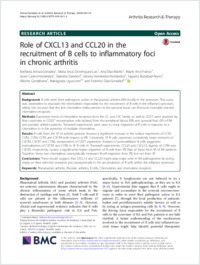Role of CXCL13 and CCL20 in the recruitment of B cells to inflammatory foci in chronic arthritis
- Armas-González, Estefanía Servicio de Reumatología, Hospital Universitario de Canarias, La Laguna, Tenerife, Spain
- Domínguez-Luis, María Jesús Servicio de Reumatología, Hospital Universitario de Canarias, La Laguna, Tenerife, Spain
- Díaz-Martín, Ana Servicio de Reumatología, Hospital Universitario de Canarias, La Laguna, Tenerife, Spain
- Arce-Franco, Mayte Servicio de Reumatología, Hospital Universitario de Canarias, La Laguna, Tenerife, Spain
- Castro-Hernández, Javier Servicio de Reumatología, Hospital Universitario de Canarias, La Laguna, Tenerife, Spain
- Danelon, Gabriela Institute for Research in Biomedicine (IRB), Faculty of Biomedical Sciences, Università della Svizzera italiana, Switzerland
- Hernández-Hernández, Vanesa Servivio de Reumatología, Hospital Universitario de Canarias, La Laguna, Tenerife, Spain
- Bustabad-Reyes, Sagrario Servivio de Reumatología, Hospital Universitario de Canarias, La Laguna, Tenerife, Spain
- Cantabrana, Alberto Servicio de Reumatología, Hospital Universitario Nuestra Señora de Candelaria, Santa Cruz de Tenerife, Tenerife, Spain
- Uguccioni Mariagrazia
- Díaz-González, Federico Departamento de Medicina Interna, Facultad de Medicina, Universidad de La Laguna, La Laguna, Tenerife, Spain - Servicio de Reumatología, Hospital Universitario de Canarias, C/Ofra s/n. La Cuesta, 38320 La Laguna, Tenerife, Spain
-
07.06.2018
Published in:
- Arthritis research & therapy. - 2018, vol. 20, p. 114
English
Background: B cells exert their pathogenic action in rheumatoid arthritis (RA) locally in the synovium. This study was undertaken to elucidate the chemokines responsible for the recruitment of B cells in the inflamed synovium, taking into account that the rich chemokine milieu present in the synovial tissue can fine-tune modulate discrete chemokine receptors. Methods: Expression levels of chemokine receptors from the CC and CXC family, as well as CD27, were assessed by flow cytometry in CD20+ mononuclear cells isolated from the peripheral blood (PB) and synovial fluid (SF) of RA and psoriatic arthritis patients. Transwell experiments were used to study migration of B cells in response to a chemokine or in the presence of multiple chemokines. Results: B cells from the SF of arthritis patients showed a significant increase in the surface expression of CCR1, CCR2, CCR4, CCR5 and CXCR4 with respect to PB. Conversely, SF B cells expressed consistently lower amounts of CXCR5, CXCR7 and CCR6, independent of CD27 expression. Analysis of permeabilized B cells suggested internalization of CXCR5 and CCR6 in SF B cells. In Transwell experiments, CCL20 and CXCL13, ligands of CCR6 and CXCR5, respectively, caused a significantly higher migration of B cells from PB than of those from SF of RA patients. Together, these two chemokines synergistically increased B-cell migration from PB, but not from SF. Conclusions: These results suggest that CXCL13 and CCL20 might play major roles in RA pathogenesis by acting singly on their selective receptors and synergistically in the accumulation of B cells within the inflamed synovium.
- Language
-
- English
- Classification
- Medicine
- License
- Open access status
- gold
- Identifiers
-
- RERO DOC 326703
- DOI 10.1186/s13075-018-1611-2
- ARK ark:/12658/srd1318905
- Persistent URL
- https://n2t.net/ark:/12658/srd1318905
Statistics
Document views: 170
File downloads:
- Texte intégral: 216
